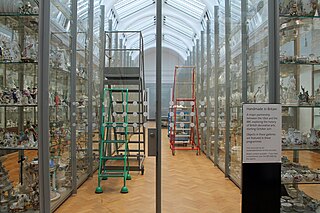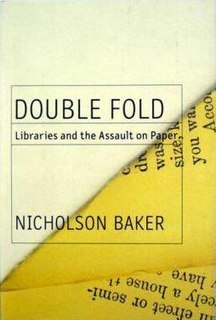 W
WIn library and archival science, preservation is a set of activities aimed at prolonging the life of a record, book, or object while making as few changes as possible. Preservation activities vary widely and may include monitoring the condition of items, maintaining the temperature and humidity in collection storage areas, writing a plan in case of emergencies, digitizing items, writing relevant metadata, and increasing accessibility. Preservation, in this definition, is practiced in a library or an archive by a librarian, archivist, or other professional when they perceive a record is in need of care.
 W
WAlways Becoming is an artwork created in 2007 by Nora Naranjo-Morse, a Native American Potter and poet. She currently resides in Española, New Mexico, just north of Santa Fe and is a member of the Santa Clara Pueblo.
 W
WCollections care, which is sometimes called preventive conservation, involves any actions taken to prevent or delay the deterioration of cultural heritage. The primary goal is to identify and reduce potential hazards to heritage with thoughtful control of their surroundings. The professions most influenced by collections care include conservator-restorers, curators, collection managers, and registrars.
 W
WCollection maintenance is a form of collections care that consists of the day-to-day hands on care of collections and cultural heritage. The primary goal of collections maintenance is to prevent further decay of cultural heritage by ensuring proper storage and upkeep including performing regular housekeeping of the spaces and objects and monitoring and controlling storage environments. Collections maintenance is closely linked to collections care and collections management. The professionals most influenced by collections maintenance include collection managers, registrars, and archivists.
 W
WCollections management involves the development, storage, and preservation of collections and cultural heritage. The primary goal of collections management is to meet the needs of the individual collector or collecting institution's mission statement, while also ensuring the long-term safety and sustainability of the cultural objects within the collector's care. Collections management, which consists primarily of the administrative responsibilities associated with collection development, is closely related to collections care, which is the physical preservation of cultural heritage. The professions most influenced by collections management include collection managers, registrars, and archivists.
 W
WThe conservation and restoration of books, manuscripts, documents and ephemera is an activity dedicated to the preservation and protection of items of historical and personal value made primarily from paper, parchment, and leather. When applied to cultural heritage, conservation activities are generally undertaken by a conservator. The primary goal of conservation is to preserve the lifespan of the object as well as maintaining its integrity by keeping all additions reversible. Conservation of books and paper involves techniques of bookbinding, restoration, paper chemistry, and other material technologies including preservation and archival techniques.
 W
WConservation and restoration of Mesoamerican codices is the process of analyzing, preserving, and treating codices for future study and access. It is a decision-making process that aims to establish the best possible methods and tools of preservation and treatment. The conservation-restoration of Mesoamerican literature is essential for understanding the ancient civilizations of Mexico. Efforts of restoration have proved difficult due to their fragility and importance of preserving historical and evidential value. Non-invasive technologies have been a more recent advancement, making analysis and treatment of pre-Hispanic codices a delayed process. As analysis continues, digitization has also been a more recent and valuable means of making information accessible to a wider audience, thus contributing to further research and preservation.
 W
WDouble Fold: Libraries and the Assault on Paper is a non-fiction book by Nicholson Baker that was published in April 2001. An excerpt appeared in the July 24, 2000 issue of The New Yorker, under the title "Deadline: The Author's Desperate Bid to Save America's Past." This exhaustively researched work details Baker's quest to uncover the fate of thousands of books and newspapers that were replaced and often destroyed during the microfilming boom of the 1980s and 1990s. Double Fold is a controversial work and is not meant to be objective. In the preface, Baker says, "This isn't an impartial piece of reporting", and The New York Times characterized the book as a "blistering and thoroughly idiosyncratic attack".
 W
WA Hollinger box, also known as a "document box" or "archives box," is a specially constructed cardboard box used in archives for preservation of documents and photographs. The term "Hollinger" refers to the manufacturer, Hollinger Metal Edge, a company founded in 1945 in Arlington, Virginia. Hollinger Metal Edge worked with officials at the Library of Congress and National Archives of the United States to develop acid free papers, storage boxes and envelopes that would preserve archival collections. The boxes are designed for long-term storage, and typically rest on standard library shelving.
 W
WThe International Dunhuang Project (IDP) is an international collaborative effort to conserve, catalogue and digitise manuscripts, printed texts, paintings, textiles and artefacts from the Mogao caves at the Western Chinese city of Dunhuang and various other archaeological sites at the eastern end of the Silk Road. The project was established by the British Library in 1994, and now includes twenty-two institutions in twelve countries. As of 18 February 2021 the online IDP database comprised 143,290 catalogue entries and 538,821 images. Most of the manuscripts in the IDP database are texts written in Chinese, but more than fifteen different scripts and languages are represented, including Brahmi, Kharosthi, Khotanese, Sanskrit, Tangut, Tibetan, Tocharian and Old Uyghur.
 W
WLibrary damage resulting from the 2004 Indian Ocean earthquake has been reported in six Asian countries. On December 26, the massive 2004 Indian Ocean earthquake struck off the northwest coast of the Indonesian island of Sumatra. The resulting tsunamis killed more than 180,000 people. In addition to the loss of human lives, cultural institutions were destroyed in several Asian nations. Libraries on the Eastern coast of Sri Lanka and the northern province of Aceh on Sumatra were most severely affected by the disaster.
 W
WMold prevention is a conservation activity that is performed in libraries to protect books and other materials from deterioration caused by mold growth. Mold prevention consists of different methods, such as chemical treatments, careful environmental control, and manual cleaning. Preservationists use one or a combination of these methods to combat mold spores in library collections.
 W
WThe National Recording Preservation Plan is a strategic guide for the preservation of sound recordings in the United States. It was published in December 2012 by the Council on Library and Information Resources (CLIR) and the National Recording Preservation Board of the Library of Congress. The plan was written by a community of specialists, but is prominently credited to Brenda Nelson-Strauss, Alan Gevinson and Sam Brylawski
 W
WThe Oregon Hops and Brewing Archives (OHBA), established in 2013, is a community archive in the U.S. dedicated to collecting, preserving, and sharing materials about the story of Northwest hops and brewing.
 W
WThe Preservation Society of Newport County is a private, non-profit organization based in Newport, Rhode Island. It is Rhode Island's largest and most-visited cultural organization. The organization protects the architectural heritage of Newport County, especially the Bellevue Avenue Historic District. Seven of its 14 historic properties and landscapes are National Historic Landmarks, and most are open to the public.
 W
WThe Providence Preservation Society is a private, non-profit organization based in Providence, Rhode Island. The organization's mission is to preserve the architectural heritage of Providence, Rhode Island. The organization was originally formed in 1956 by area residents including preservationist Antoinette Downing to preserve historic 18th and 19th century buildings on College Hill which were threatened with demolition. The Society owns several buildings including the Brick Schoolhouse (1768) and Shakespeare's Head building (1772) and garden.
 W
WA slow fire is a term used in library and information science to describe paper embrittlement resulting from acid decay. The term is taken from the title of Terry Sanders' 1987 film Slow Fires: On the preservation of the human record.
 W
WA Solander box, or clamshell case, is a book-form case used for storing manuscripts, maps, prints, documents, old and precious books, etc. It is commonly used in archives, print rooms and libraries. It is named after the Swedish botanist Daniel Solander (1733–1782), who is credited with its construction while working at the British Museum, where he catalogued the natural history collection between 1763 and 1782.
 W
WTimbuktu Manuscripts is a blanket term for the large number of historically important manuscripts that have been preserved for centuries in private households in Timbuktu, Mali. The collections include manuscripts about art, medicine, philosophy, and science, as well as copies of the Quran. The number of manuscripts in the collections has been estimated as high as 700,000.